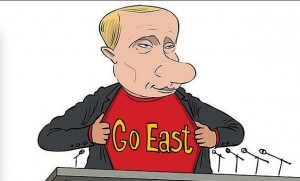The 26th, and perhaps most anticipated, iteration of the Asia-Pacific Economic Cooperation (APEC) summit concluded Tuesday, kicking off a busy week for several of the world’s most powerful leaders. The 2014 edition was set against a backdrop of tempered global economic growth, Russia’s declining relationship with the West, continued Chinese and Japanese dispute, and of course low oil prices. President Putin launched, in earnest, his country’s Asian pivot.
The 21-member nation forum – headlined by China, Russia, and the United States accounts for nearly 40 percent of the world’s population, 55 percent of world GDP, and approximately 60 percent of world energy consumption.
Of the member economies, perhaps none was more eager to get the ball rolling than Russia. Last week, Russia’s central bank slashed economic growth forecasts for 2015 and predicted record capital outflows. Moreover, the bank anticipates Western sanctions, which have limited the country’s development of their vast energy reserves, will last until at least the end of 2017. Dependence on oil revenue remains dangerously high, but the ill effects of declining prices have actually been stemmed by the more rapid collapse of the ruble, down nearly 30 percent on the year.
With his sights firmly set on the East, Putin acted quickly and inked a second big gas deal with his Chinese counterpart Xi Jinping. The accord, signed Nov. 9th, follows the 30-year, $400 billion deal signed in May, which will move up to 38 billion cubic meters (bcm) per year through the 2,500 mile Power of Siberia pipeline currently under construction. The two nations’ most recent cooperation centers on the long-discussed Altai pipeline – a 1,700 mile route from Russia’s productive Western Siberian fields to China’s restive Xinjiang region. Under the new deal, China will purchase an additional 30 bcm of gas for a period of 30 years. Once both pipelines are complete, China will become Russia’s largest gas customer, surpassing Germany.
It’s been a busy year for Putin and Jinping, who last month opened a currency-swap line. The yuan-ruble swap line worth approximately $25 billion will allow both countries easier access to the other’s currency, facilitating greater trade and investment, especially in the financial and energy sectors. As both countries look to decrease their economic dependence on the West, China is buying into assets across Russia. Heavily indebted state-owned Rosneft just sold 10 percent of its highly productive Vankor project to China National Petroleum Corporation, and Yamal LNG – a sanctions-hit megaproject in Siberia – may soon add more than $10 billion in additional Chinese investment.
